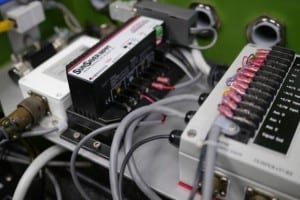Journalist Doualy Xaykaothao with KERA public radio covered the research of SMU seismologist Heather R. DeShon.
DeShon is leading the effort to trace the source of a recent sequence of small earthquakes in North Texas and any relationship they may have to the injection of waste water by energy companies using shale gas production to recover gas.
North Texas earthquakes occurring in the Reno-Azle area since Nov. 5, 2013, and in Mineral Wells since Nov. 28, 2013, have raised scientific questions about the nature of these sequences and heightened local and national concerns about the impact of shale gas production on infrastructure and subsurface structures.
The KERA broadcast aired Feb. 10, “What’s Causing Quakes? SMU Scientists Aim To Finish Seismic Study In Two Years.”
DeShon, an associate professor of geophysics, is an expert in earthquake generation within subduction zones and intraplate settings, seismogenic zone processes, local earthquake tomography and volcano seismology.
EXCERPT:
By Doualy Xaykaothao
KERA
Researchers from Southern Methodist University say folks shouldn’t rush to conclusions about what’s been causing the swarm of more than 30 earthquakes northwest of Fort Worth since November.Scientists have installed a temporary seismic network in and around the earthquake swarm to help gain a better understanding of the quakes.
On Friday, in the basement of SMU’s Department of Earth Sciences, professors gathered in front of colorful waves from seismic stations.
Professor Brian Stump is part of SMU’s research team. He said those waves are what they use to pinpoint earthquakes, and more carefully examine each acceleration.
“Talking about how earthquakes generate waves,” Stump says. “That may be too technical, but it does help you understand what you’re feeling.”
To understand earthquakes, consider what happens when you drop a rock in a pond, he said.
“You can see the waves spread out from that rock,” Stump says. “And they get farther and farther apart, the farther they propagate. Same thing happens in the earth. The fault slips and it generates waves, but it generates two kinds of waves” — a “P” wave and an “S” wave. The “S” wave travels slower, he says.
“So you may feel the first ‘P’ wave, which is a pop or a bang, and then you may feel a kind of rolling motion that’s associated with the ‘S’ wave,” he said.
Follow SMUResearch.com on Twitter.
For more information, www.smuresearch.com.
SMU is a nationally ranked private university in Dallas founded 100 years ago. Today, SMU enrolls nearly 11,000 students who benefit from the academic opportunities and international reach of seven degree-granting schools. For more information see www.smu.edu.
SMU has an uplink facility located on campus for live TV, radio, or online interviews. To speak with an SMU expert or book an SMU guest in the studio, call SMU News & Communications at 214-768-7650.



 Wall Street’s short sellers wrongly maligned — detected red flags ahead of US financial crisis
Wall Street’s short sellers wrongly maligned — detected red flags ahead of US financial crisis A director’s skills, experiences and workload drive their compensation, SMU study finds
A director’s skills, experiences and workload drive their compensation, SMU study finds Gut reaction of marital partners could foretell their marriage satisfaction
Gut reaction of marital partners could foretell their marriage satisfaction Fossil supervolcano discovered in Italy by SMU-led team is now key feature of new UNESCO Geopark
Fossil supervolcano discovered in Italy by SMU-led team is now key feature of new UNESCO Geopark NPR: “Boiling Hot: How Fracking’s Gusher of Geothermal Energy is Wasted”
NPR: “Boiling Hot: How Fracking’s Gusher of Geothermal Energy is Wasted” KERA, NOVA: SMU researcher Peter Weyand discusses the upper limits of human speed.
KERA, NOVA: SMU researcher Peter Weyand discusses the upper limits of human speed.
 The Undying Radio: Familiarity breeds content when it comes to listeners and music
The Undying Radio: Familiarity breeds content when it comes to listeners and music